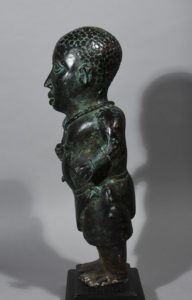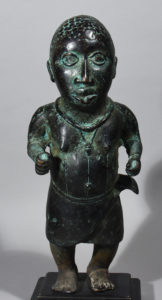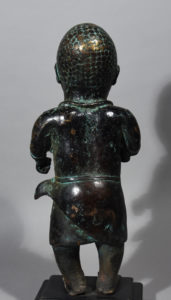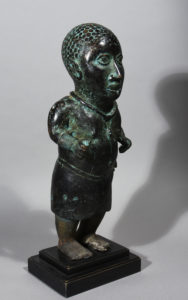VRK 0217-1
Benin Dwarf “Court Jester”, bronze, Edo People, Nigeria
Dwarfs have a very specific role at the court of Oba in Benin. They functioned as court jesters in Benin since the 15th century. Their responsibilities go beyond amusement to include the care of certain shrines, overseeing activities in the market, gathering information for the oba, and protecting him from deception and witchcraft. These highly individualized sculptures may be portraits, a rarity in Benin. It is tempting to speculate that this one wearing an ornamental pendant and a necklace appears to be very serious. He is all attention and poise, thus may represent the dwarf who is recorded in Benin’s oral history, as the one associated with Oba Ewuare.
Court dwarfs enjoyed specific placement right next to the king or queen in a royal court during public appearances and ceremonies, because they were so small, the king appeared much larger and visually enhanced his powerful position.
From the earliest historic times dwarfs attracted attention, and there was much competition on the part of kings and the wealthy to obtain dwarves as attendants. Ancient Egypt saw dwarfs as being people with significant sacred associations, so owning a dwarf gave a person high social stature.
British tradition has its earliest dwarf mentioned in the old ballad which begins “In Arthur’s court, Tom Thumb did live,” and on this evidence the prototype of the modern Tom Thumb is alleged to have lived at the court of King Edgar. Among authentic English dwarfs the first appears to be John Jarvis 2 feet (0.61 m), who was page to Queen Mary I. Her brother King Edward VI had his dwarf called Xit.
Back in the late 19th century when the British forces invaded Benin City, they were overwhelmed to find artistic sculptures cast in brass/bronze. They could not believe the technological sophistication and exquisite beauty and quality of these objects. What they saw was a total contradiction to what many westerners believed or assumed about Africa. The above was too much for the British forces to bear and they swiftly concocted excuses – “The sculptures must have been made by the Portuguese, the Egyptians, or the lost tribes of Israel”.
Many Benin bronzes, or the so-called “Portuguese, Egyptian or Israeli” sculptures came into limelight after the British Punitive Expedition of 1897 when the palace of the King of Benin was pillaged, the ceremonial artworks plundered and carted away, the city burnt and made desolate, with the King (Oba Ovonranmwen) sent to exile in Calabar and eventually, parts of the ‘booties’ found its way to Britain and later on to other parts of Europe and USA. The looted artworks, were sold off in the UK to offset the cost of the expedition. Many of the bronzes ended up in British museums and in the hands of private collectors all around Europe and USA. This Court Dwarf has been recently acquired from a USA tribal art antique dealer.
However, the soldiers instead of being paid salaries was allowed to take as war booty an unknown number of objects which they sold at the harbor and in harbor pubs around Portsmouth. Among these affects you may find today around in auctions and art dealers store around the world.
It can be extremely difficult to judge the age of bronze effects. However, the exceptionally fine casting and the delicate surface suggest that the figure dates back to the beginning of the 18th century. Which corresponds to the time when the Benin court gets in touch with the European royal houses.
Conditions: This bronze Court Dwarf is unique and made by the ‘cire perdue method’. Also called ´the lost wax process´ involves the making of the item in wax first. Clay is packed around the wax, then the wax is melted out of the clay, and molten bronze is poured into the hollow mold. Despite age, this figure with its beautiful light-green verdigris surface is in an exceptionally good condition. No cracks or cuts.
Dimension: H: 43, W: 17 and D: 14 cm – weight 3.4 kilos
Provenance: USA private collection – acquired via NY-art dealer.
Literature: “Art and science in Benin bronzes” by Joseph Nevadomsky, African Arts, Spring, 2004
https://news.artnet.com/art-world/benin-bronzes-restitution-1322807








